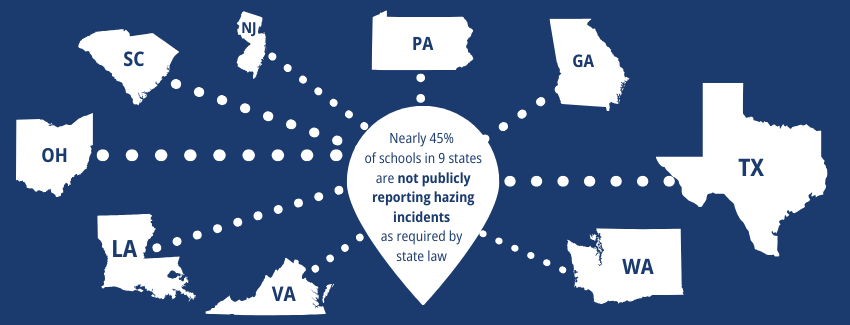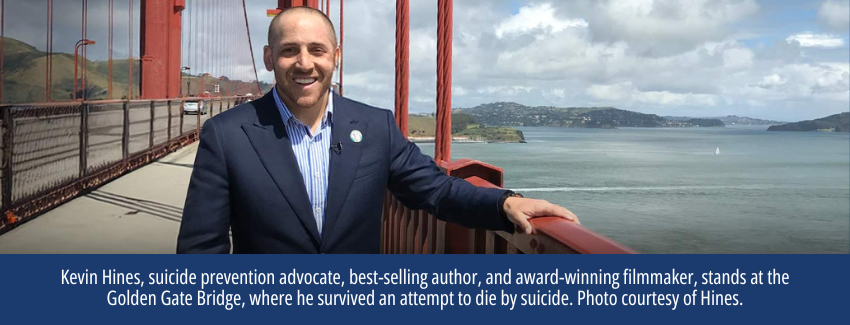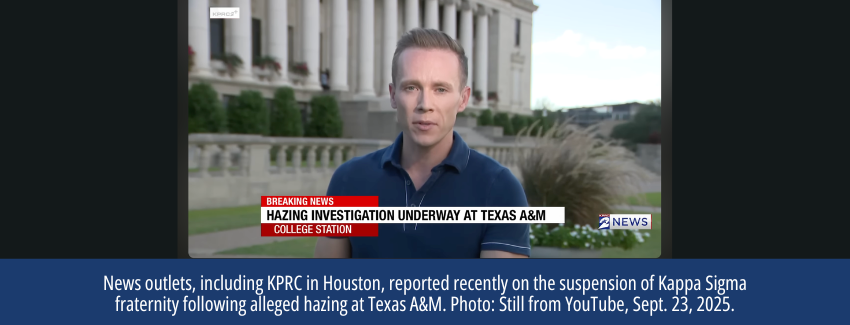Why aren't colleges reporting hazing incidents?
Even when it's the law, nearly half of colleges and universities aren't publishing hazing incident reports
Nearly half of colleges and universities are not meeting their legal obligations to publicly report incidents of hazing — even when their own state laws require them to report.
That’s a key finding from a new review of data collected by HazingInfo.org from 467 US colleges and universities in nine states.
Laws in nine states require their colleges and universities to make available to the public all incidents in which authorities have formally concluded that hazing occurred. Those nine states are Georgia, Louisiana, New Jersey, Ohio, Pennsylvania, South Carolina, Texas, Virginia, and Washington.
The HazingInfo.org team manually collected hazing data from all four-year, public and private institutions in those states to conduct the first review of how states are complying with hazing transparency laws.
What we found is a lack of consistency, with each school deciding for itself how to respond — or even whether to respond — to its own state hazing law.
How schools are responding to hazing transparency laws
Out of 467 schools, some 47% are not publicly reporting hazing incidents as required by state law, according to HazingInfo’s review.
For example, of Georgia’s 55 institutions of higher education, just 25 have publicly accessible hazing reports on their websites.
That’s despite the 2021 passage of the Max Gruver Act, which requires all colleges and universities to publicly post transparency reports for a minimum of five years when hazing incidents are adjudicated, updated within 15 calendar days of final findings or public notice of criminal conviction.
In Louisiana — where freshman Max Gruver was killed in 2017 by fraternity hazing at Louisiana State University (LSU) — the record is even worse. Just 4 out of 22 Louisiana colleges and universities share hazing incident data publicly as required by state law.
LSU is one of the universities that does not provide public access to information on reported hazing.
Colleges and universities with no hazing incident report, by state:
- Georgia: 30 out of 55 institutions
- Louisiana: 18 out of 22 institutions
- New Jersey: 10 out of 30 institutions
- Ohio: 24 out of 69 institutions
- Pennsylvania: 30 out of 97 institutions
- South Carolina: 21 out of 33 institutions
- Texas: 36 out of 81 institutions
- Virginia: 32 out of 49 institutions
- Washington: 21 out of 31 institutions
Lack of consistency in how campuses report hazing
Even those institutions that do report hazing data vary widely in the details they provide, the timeliness of their reports, and how easy it is to find the information.
Many schools bury their hazing incident reports deep on webpages that make them difficult to find. It is not uncommon to have to scroll down a long webpage to find a link to a hazing transparency report at the bottom of the page.
In some cases, it appears colleges and universities responded to hazing reporting requirements when their state laws initially took effect but never followed through in subsequent years, leaving new classes of students and families in the dark.
At South Georgia State College, for example, university officials created a form for displaying hazing incidents, but it is left blank. That could mean there are no incidents, but it hasn’t been updated since summer 2021, the year the Max Gruver law passed, so parents and students can’t be sure.
In Virginia, Hampden-Sydney College, a private college for men, says half of its students join one of its 10 nationally chartered fraternities.
But users have to scroll to the bottom of its Greek life page, where there’s a link to a hazing misconduct report that is undated and empty. Parents and students are left unclear on the context or history of hazing misconduct.
Hampden-Sydney College has no hazing policy and no obvious way to report hazing listed on the college’s website. Yet many of the national fraternities on its campus have gotten in trouble repeatedly for hazing at other campuses, including Kappa Alpha Psi and Sigma Chi.
Proposed federal legislation called the Stop Campus Hazing Act would bring consistency to hazing reporting. It requires colleges to include hazing incidents in their annual security reports (or Clery reports) and to publish their hazing prevention policies and the organizations that have violated them.
Some campuses commit to transparency; others ignore state reporting laws
Even within the same state, schools are inconsistent in whether and how they report hazing data. That makes it challenging for students, parents, and others to locate information and interpret what they find to gauge how schools are responding to campus hazing.
In Texas, for example, the University of Houston makes it easy to find its comprehensive hazing policy and up-to-date, detailed hazing incident report by searching for “hazing” on its homepage. There is also an online form where you can report hazing and a contact email address for the Dean of Students office, which handles student behavior and conduct issues.
However, just a half-mile away at Texas Southern University, a search for “hazing” on the university’s website yields the school’s hazing policy (a restatement of Texas state law, rather than a school-specific policy). But there is no hazing report as required by law, nor is there a school contact or an online form to report hazing.
Explore the HazingInfo.org database to see how colleges and universities in the nine states are responding to campus hazing and their state laws.




